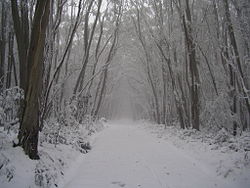
Back جبل لاك ARZ Lake Mountain (bukid sa Ostralya, State of Victoria) CEB Lake Mountain German Lake Mountain French Lake Mountain (Victoria) LLD Lake Mountain Swedish
| Lake Mountain | |
|---|---|
 A ski trail at Lake Mountain following a snowfall | |
| Highest point | |
| Elevation | 1,433 m (4,701 ft)[1] |
| Coordinates | 37°30′16″S 145°52′56″E / 37.50444°S 145.88222°E[2] |
| Geography | |
Location near Shire of Murrindindi | |
| Location | Victoria, Australia |
| Parent range | Cathedral Range, Great Dividing Range |
| Climbing | |
| First ascent | unknown |
| Easiest route | Short hike from carpark |
| Lake Mountain Alpine Resort | |
|---|---|
| Location | Lake Mountain |
| Nearest major city | Melbourne, Victoria |
| Coordinates | 37°31′01″S 145°52′51″E / 37.51694°S 145.88083°E |
| Vertical | 150 metres (490 ft) |
| Top elevation | 1,480 metres (4,860 ft) |
| Base elevation | 1,330 metres (4,360 ft) |
| Website | www |
Lake Mountain is a 1,433-metre-high (4,701 ft) mountain peak on a plateau that hosts a cross-country ski resort that is known by the same name. It is located in Victoria, Australia, approximately 120 kilometres (75 mi) north-east of Melbourne. The 1,483-metre-high (4,865 ft) Mount Bullfight, which is within the Mount Bullfight Nature Conservation Reserve, is the highest peak that can be reached by a cross-country ski trail from Lake Mountain. Access to Lake Mountain's summit is restricted to a snow shoe track in winter. The Lake Mountain Alpine Resort, located near Lake Mountain, is the most popular ski resort in Australia when measured in terms of total visitor numbers, including sightseers, due to its proximity to Melbourne.[citation needed]
The Lake Mountain Alpine Resort is surrounded by the Yarra Ranges National Park into which its ski trails lead. The resort is an unincorporated area under the direct administration of the government of Victoria, and is surrounded to the west, north & east by the Shire of Murrindindi and Yarra Ranges Shire to the south.[3]
There is no lake at Lake Mountain. It is claimed that the mountain was named after George Lake, who was the surveyor-general of the area.[citation needed] Contradicting this, VICNames says that it is named for the "tarns, ponds and bogs near the summit".[4]
- ^ "Lake Mountain, Australia". Peakbagger.com. Retrieved 8 August 2014.
- ^ "Lake Mountain: 19172". Vicnames. 2 May 1966. Archived from the original on 8 August 2014. Retrieved 8 August 2014.
- ^ Brian Pink (July 2008). "Australian Standard Geographical Classification (ASGC) - Victoria maps" (PDF).
- ^ "VICNAMES - The Register of Geographic Names: Lake Mountain". maps.land.vic.gov.au. Retrieved 15 June 2021.
